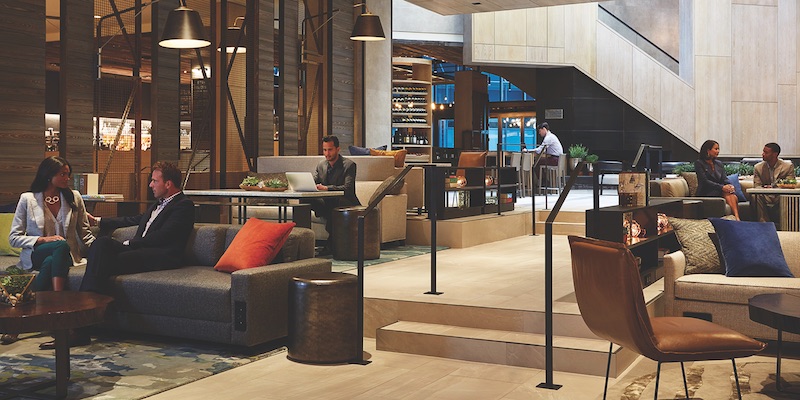Ten years from now, a hotel stay will be a much different experience than today. Picture this: As you approach the property entrance, you see a massive art installation illuminated by an LED light show. You walk through the door to the lobby, bypass the check-in area, and are guided to your room by your smartphone and dynamic digital signage.
Your phone unlocks your door, and as you step into the room, you notice that the temperature has already been set to 71 F—just how you like it. The window blinds are closed, and the lighting level and color temperature adjusts to help you acclimate to a new time zone by resetting your circadian clock.
Hospitality companies are testing an array of such technologies so that over the next half-decade they can personalize your stay, wow you with unique features, and create a distinctive sense of place. Design firms are more involved than ever in researching the possibilities of reshaping the guest experience. Some of the enhancements in next-generation hotels will be inconspicuously embedded into the built environment. Others will be obvious.
Hotel designers must think beyond the bricks and mortar as emerging technologies play a more prominent role in the guest experience. Artificial intelligence, robotics, state-of-the-art video projection, and voice-activated controls are all fodder for new experiential design. Hotel brands will use these technologies to distinguish themselves from competitors.
Of course, there will still be a market for economical places for travelers to spend a night or two, and these properties likely will be slow to adopt new technology. For higher-end hotels and destination resorts, though, there could be a tech arms race in the works.
“A hotel will no longer succeed if it’s just a place to sleep,” says Michael Schneider, Senior Experience Designer and AV Technical Strategist with ESI Design, in New York City. The goal is to provide guests with distinctive moments and memories. “It’s about creating iconic experiences, Instagramable moments,” adds ESI’s Greg Gallimore, the firm’s Director of Media Architecture.
Here are six trends shaping the future of hotels:
1. A/V steps up to create true destination spaces
In what might be a harbinger of the future, ESI designed an interactive LED light sculpture installed in the front plaza of a mixed-use hotel and office property in Washington, D.C. People in proximity to the installation can see their movements reflected in the light. “It has become an iconic part of the community and emphasizes its public nature,” says Gallimore.
The opportunities for A/V technology to enhance experiences at destination resorts are enormous. At a redevelopment of Queen Mary Island in Long Beach, Calif., Gensler is considering features such as drive-through walls of video screens that could project images to whet guests’ appetites for the experiences inside. A/V could be used liberally throughout the Queen Mary property, which is a hotel itself, to inform guests about the history of the ship, sea life, and the state, says Steven Upchurch, AIA, Managing Director, Principal, and Firmwide Hospitality Practice Area Leader with Gensler.
LED and digital image projection technology can be used effectively within a hotel, too. For example, the lobby of the 900 North Michigan Avenue Shops in Chicago features a 4,000-sf ceiling that serves as the screen for a dazzling light and image show of sky, trees, birds, kaleidoscope effects, and other imagery. Interspersed are logos and products—think Gucci handbags, luxury chocolates—of the mall’s retailers. Many guests at the adjoining Four Seasons hotel enter the property through this atrium lobby, so the space functions as a hotel lobby of sorts.
2. TechnologY fosterS hyper-personalized service
Other elements of hotel lobbies may change, though more subtly. For instance, “you won’t see big airline-type check-in counters,” says Shawn Basler, AIA, Principal, Executive Director, and Hospitality Practice Leader with Perkins Eastman. Like airlines that offer check-in before arriving at the airport, hotel guests will be able to check-in prior to arrival if they choose. In luxury hotels, in particular, there will be staff to greet guests as they arrive in the lobby. Equipped with a mobile device, attendants will provide personal service, helping guests to customize their rooms and experience.
That service may be critical, as big hotel companies such as Marriott International, with its Innovation Lab, are testing new electronic products and automated features that enable guests to set the ambience of their rooms. Guests may need an introduction to the technology to get it to work according to their wishes. Sophisticated lighting options, projection video, aroma features, temperature control, smart windows that control the amount of ambient light, and music over Bluetooth speakers could all be managed from guests’ smartphones or in-room control panels. Voice-activated controls such as Alexa and Siri could simplify this activity.
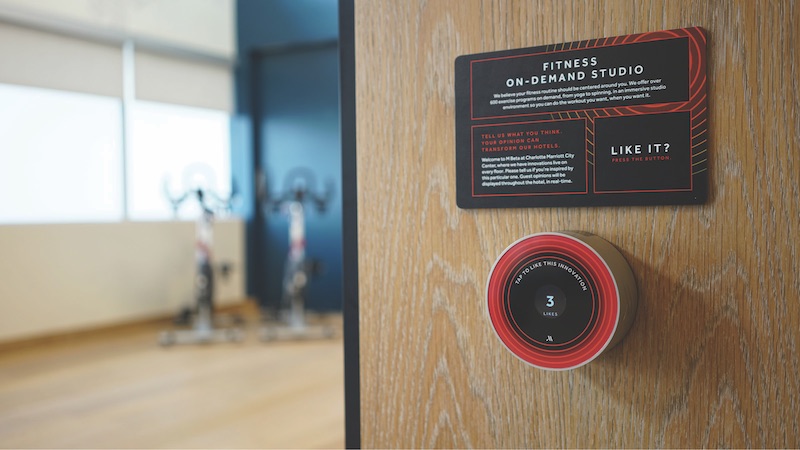 The hotel allows for rapid prototyping and invites guests to test and give feedback in real-time via Beta Buttons (below) located throughout the spaces. Photo: Marriott International.
The hotel allows for rapid prototyping and invites guests to test and give feedback in real-time via Beta Buttons (below) located throughout the spaces. Photo: Marriott International.
3. Lighting is fine-tuned to create “feel good” spaces
Optimizing LED lighting may be critical, as the ongoing transition to this technology still has many confused as to which levels of color temperature and brightness are optimal.
“Most people don’t understand why they feel good in a space,” says Clay Markham, AIA, LEED AP, Senior Vice President and Global Hospitality Leader with CallisonRTKL. “It’s mostly because of lighting.”
Lighting holds promise to relieve jet lag. Researchers are investigating how altering lighting can help people reset circadian rhythms, and hotels are an obvious venue to adopt such features, says Gallimore.
Finding your way around a big hotel or resort may be quite different in a decade or so. You may be able to search for your room by following fiber optic light indicators embedded in the carpet. If you let your phone alert the hotel’s computer system of your destination, dynamic signs on the walls could guide you there, as your phone acts as a beacon tracking your progress through the property.
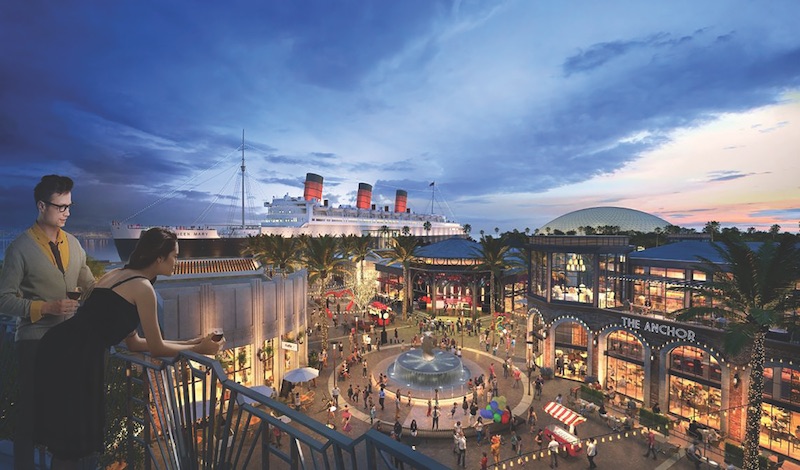 For the redevelopment of Queen Mary Island in Long Beach, Calif., Gensler is considering features such as drive-through walls of video screens that could project images to whet guests’ appetites for the experiences inside. A/V could be used throughout the property, which is a hotel itself, to inform guests about the history of the ship, sea life, and the state.
For the redevelopment of Queen Mary Island in Long Beach, Calif., Gensler is considering features such as drive-through walls of video screens that could project images to whet guests’ appetites for the experiences inside. A/V could be used throughout the property, which is a hotel itself, to inform guests about the history of the ship, sea life, and the state.
4. AI, robots—and human staff—learn from the guests
In the hotel of the future, your phone could be the talisman for the property to monitor your whereabouts and activity on site. Combining real-time data and a database that contains many of your preferences, you might walk up to the pool bar where the bartender would greet you by name and ask if you’d like your favorite drink.
Let’s say you are with a group of college friends. The poolside DJ, being fed information about your group, might be prompted to play tracks hearkening back from your days at State U. The property would compile a detailed digital dossier on guests’ preferences (e.g., Do you prefer hard or soft pillows?) and tailor your experience accordingly. Your social media activity could further inform the hotel’s knowledge of your tastes. That’s the vision, anyway. You have to wonder, though, if hotels go too far, would guests view it as a privacy issue?
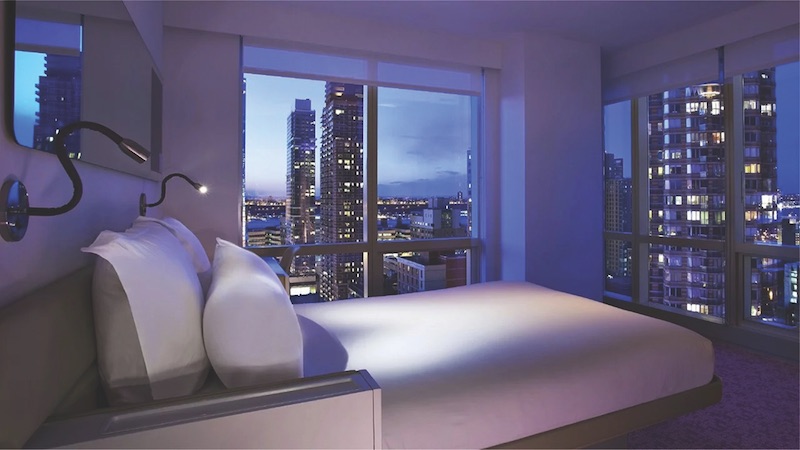 Similar to its locations in Singapore, London, Paris, and Boston, the Yotel in Midtown Manhattan features robotic luggage storage, high-tech micro rooms (170 sf on average), a mobile concierge app, online check-in, space-saving convertible beds, and blazing-fast WiFi. Courtesy Yotel.
Similar to its locations in Singapore, London, Paris, and Boston, the Yotel in Midtown Manhattan features robotic luggage storage, high-tech micro rooms (170 sf on average), a mobile concierge app, online check-in, space-saving convertible beds, and blazing-fast WiFi. Courtesy Yotel.
At least one Hilton Grand Vacations property is already tracking data on how many guests are using various amenities to offer more of things that are most used on the property, says Gensler’s Upchurch.
You might also see robots popping up to do things like deliver room service, assist with check-in, and handle luggage. Automation and robotics, in fact, already run the 100-room Henn-na Hotel in Tokyo, Japan. Human staff is deployed only for emergencies. Guests have described interacting with the robots—some of which take the form of traditional hotel bellhops, others velociraptors and kitschy toy robots—as “like talking to Siri’s younger, dumber sibling.”
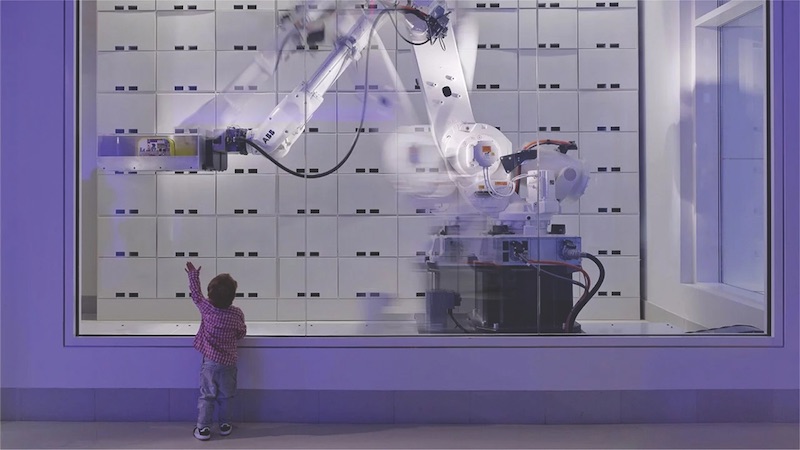 Courtesy Yotel.
Courtesy Yotel.
As hotel executives consider adopting these technologies, there is concern about striking the right balance between digital gizmos and the human touch. According to research by CallisonRTKL, 44% of guests would like to speak to a staff member during check-in, and 60% have more than a few hesitations about staying in a hotel entirely operated by robots.
And what happens when technology breaks down? “Nobody in maintenance can fix a robot at 2 a.m.,” says Marc Ciafardini, Senior Interior Designer with Wilson Associates.
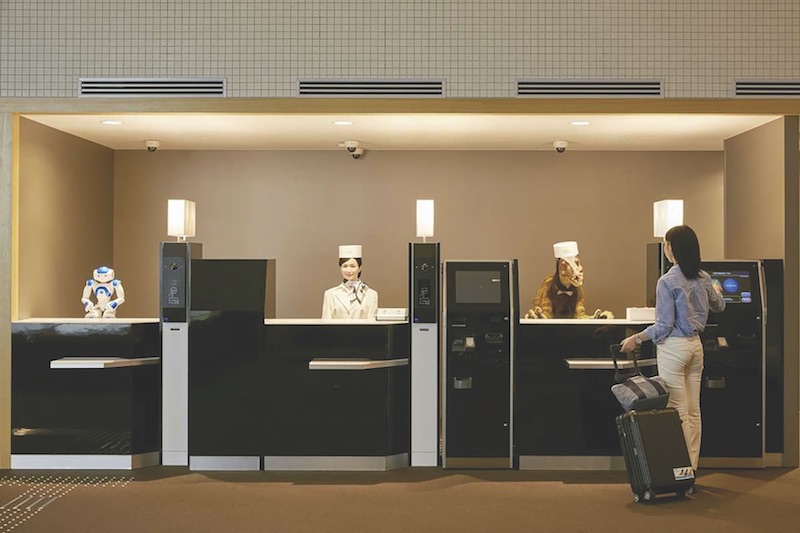 The 100-room Henn-na Hotel in Tokyo, Japan, is almost entirely staffed by robots and automation technology. Human staff is deployed only for emergencies. Its robots take the form of traditional hotel bellhops, velociraptors, and kitschy toy robots. Courtesy Huis Ten Bosch Co.
The 100-room Henn-na Hotel in Tokyo, Japan, is almost entirely staffed by robots and automation technology. Human staff is deployed only for emergencies. Its robots take the form of traditional hotel bellhops, velociraptors, and kitschy toy robots. Courtesy Huis Ten Bosch Co.
5. Building systems “automate” wellness, operational efficiency
Building automation is likely to be used more extensively for improving energy efficiency, enhancing guest wellness initiatives, and simplifying maintenance. At the Omni Frisco (Texas) Hotel, guestrooms are equipped with a kill switch. “When you take your keycard with you and leave the room, an automated switch kills power to the room,” says Ciafardini. This boosts energy efficiency by automatically shutting down lights, TVs, clocks, etc., without depending on human action.
Automation technology that immediately notifies maintenance staff of burned out lightbulbs and other failures could be adopted more widely.
When hotel providers consider automated building systems, there will be more emphasis on wellness, says Basler. Technology will play a greater role not only in controlling lighting levels, but also in air quality and water quality. “Guests want to know what sustainability is doing for them,” says Basler. “People are now more aware of how light and air quality affects them in their workplace and what their carbon footprint is.”
6. Modular construction goes mainstream
Significant changes are on the way in how many hotels are constructed, with entire rooms being fabricated off site. Marriott, for one, has turned to modular largely to enable its ambitious volume of construction—about 1,500 hotel projects in its current pipeline. Concerned that a construction labor shortage could act as a drag on its plans, Marriott sees modular as a key to staying on track.
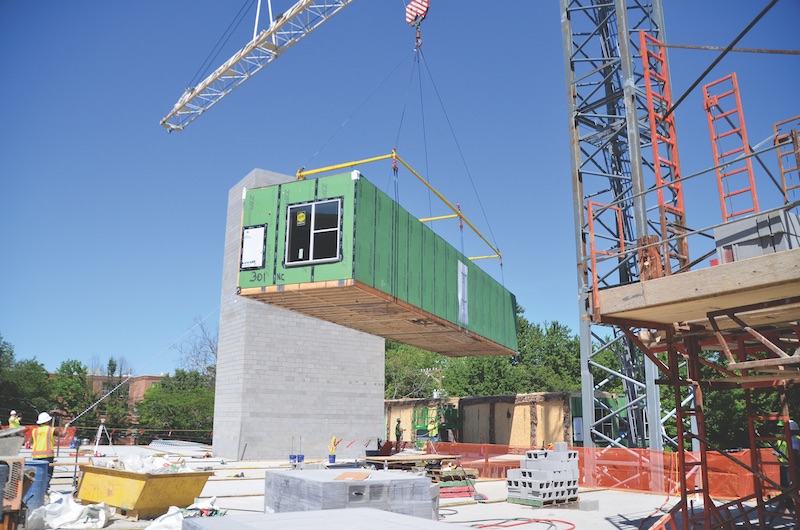 Last fall, Marriott opened its third modular-built hotel, the AC Hotel in Chapel Hill, N.C. The company’s Senior Director of Global Design Strategies, Jennifer Lund, says the process shaved a “couple of months” off the construction schedule compared to a traditionally built property. Marriott International.
Last fall, Marriott opened its third modular-built hotel, the AC Hotel in Chapel Hill, N.C. The company’s Senior Director of Global Design Strategies, Jennifer Lund, says the process shaved a “couple of months” off the construction schedule compared to a traditionally built property. Marriott International.
“We believe at least 40% of our projects could be built modular,” says Jennifer Lund, Senior Director of Global Design Strategies with Marriott. In the fall of 2017, the company opened a modular-built AC Hotel, its third modular project, in Chapel Hill, N.C. The modular process shaved a “couple of months” off the construction schedule compared to a traditionally built property, says Lund. There were other benefits including reduced noise and less disruption to the neighborhood.
“It was a tight, semi-urban location,” says Lund. “The community didn’t want a lot of disruption from construction. By using modular we were able to minimize noise, traffic, and trash.”
Related Stories
| Aug 11, 2010
Florida mixed-use complex includes retail, residential
The $325 million Atlantic Plaza II lifestyle center will be built on 8.5 acres in Delray Beach, Fla. Designed by Vander Ploeg & Associates, Boca Raton, the complex will include six buildings ranging from three to five stories and have 182,000 sf of restaurant and retail space. An additional 106,000 sf of Class A office space and a residential component including 197 apartments, townhouses, ...
| Aug 11, 2010
America's Greenest Hospital
Hospitals are energy gluttons. With 24/7/365 operating schedules and stringent requirements for air quality in ORs and other clinical areas, an acute-care hospital will gobble up about twice the energy per square foot of, say, a commercial office building. It is an achievement worth noting, therefore, when a major hospital achieves LEED Platinum status, especially when that hospital attains 14 ...
| Aug 11, 2010
3 Hospitals, 3 Building Teams, 1 Mission: Optimum Sustainability
It's big news in any city when a new billion-dollar hospital is announced. Imagine what it must be like to have not one, not two, but three such blockbusters in the works, each of them tracking LEED-NC Gold certification from the U.S. Green Building Council. That's the case in San Francisco, where three new billion-dollar-plus healthcare facilities are in various stages of design and constructi...
| Aug 11, 2010
Westin Hotel
Mid-twentieth-century projects are in a state of limbo. In many cities, safeguards against quick demolition don't even cover “new” buildings built after 1939, yet many such buildings may be obsolete by current standards. The Farmers and Mechanics Savings Bank, located in downtown Minneapolis, was one such building, a rare example of architecture from a time when American design was ...
| Aug 11, 2010
Platinum Award: Monumentally Hip Hotel Conversion
At one time the tallest building west of the Mississippi, the Foshay Tower has stood proudly on the Minneapolis skyline since 1929. Built by Wilbur Foshay as a tribute to the Washington Monument, the 30-story obelisk served as an office building—and cultural icon—for more than 70 years before the Ryan Companies and co-developer RWB Holdings partnered with Starwood Hotels & Resor...
| Aug 11, 2010
Hilton President Hotel
Once an elegant and fashionably trendy locale, the Presidential Hotel played host to the 1928 Republican National Convention where Herbert Hoover was nominated for President, and acted as a hot spot for Kansas City Jazz in the '30s and '40s. The hotel was eventually abandoned in 1984, at which point it became a haven for vagabonds and pigeons, collecting animal waste and incurring significant s...
| Aug 11, 2010
CityCenter Takes Experience Design To New Heights
It's early June, in Las Vegas, which means it's very hot, and I am coming to the end of a hardhat tour of the $9.2 billion CityCenter development, a tour that began in the air-conditioned comfort of the project's immense sales center just off the famed Las Vegas Strip and ended on a rooftop overlooking the largest privately funded development in the U.
| Aug 11, 2010
The softer side of Sears
Built in 1928 as a shining Art Deco beacon for the upper Midwest, the Sears building in Minneapolis—with its 16-story central tower, department store, catalog center, and warehouse—served customers throughout the Twin Cities area for more than 65 years. But as nearby neighborhoods deteriorated and the catalog operation was shut down, by 1994 the once-grand structure was reduced to ...
| Aug 11, 2010
Great Solutions: Healthcare
11. Operating Room-Integrated MRI will Help Neurosurgeons Get it Right the First Time A major limitation of traditional brain cancer surgery is the lack of scanning capability in the operating room. Neurosurgeons do their best to visually identify and remove the cancerous tissue, but only an MRI scan will confirm if the operation was a complete success or not.
| Aug 11, 2010
Gold Award: Westin Book Cadillac Hotel & Condominiums Detroit, Mich.
“From eyesore to icon.” That's how Reconstruction Awards judge K. Nam Shiu so concisely described the restoration effort that turned the decimated Book Cadillac Hotel into a modern hotel and condo development. The tallest hotel in the world when it opened in 1924, the 32-story Renaissance Revival structure was revered as a jewel in the then-bustling Motor City.


